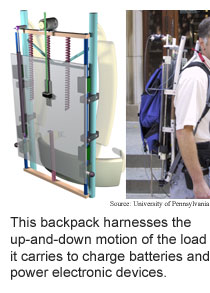
Week
of September 12, 2005
Power
walking
Someday in the not too distant future, as you carry an increasingly
burdensome backpack down a seemingly endless trail, you might be able
to take comfort in at least not having to carry extra batteries.
 Researchers from the University of Pennsylvania have developed a backpack
that generates electricity by letting its load slide up and down against
the frame. The motion is captured by a pinion gear that is attached to
an electrical generator. The process generates serious amounts of electricity
-- nearly 3 watts for a 44 pound load at a brisk walking pace of 4 miles
per hour and as much as 7.37 watts for an 84 pound load at the same speed.
Handheld devices like cellphones typically require less than a watt and
citizens band radios take 5 to 7 watts.
Researchers from the University of Pennsylvania have developed a backpack
that generates electricity by letting its load slide up and down against
the frame. The motion is captured by a pinion gear that is attached to
an electrical generator. The process generates serious amounts of electricity
-- nearly 3 watts for a 44 pound load at a brisk walking pace of 4 miles
per hour and as much as 7.37 watts for an 84 pound load at the same speed.
Handheld devices like cellphones typically require less than a watt and
citizens band radios take 5 to 7 watts.
Generating electricity this way requires only a little more exertion
from the backpack wearer than it would take to carry an ordinary backpack;
the food needed to fuel the extra exertion weighs far less than the equivalent
batteries, according to the researchers. The backpack wearer's walking
mechanics change when carrying the sliding load compared to the fixed
load, which probably accounts for the efficiency of the device.
The backpack could be used to charge batteries and power mobile
devices, including cellphones, global positioning system receivers and
night vision goggles, according to the researchers.
(Generating Electricity While Walking with Loads, Science,
September 9, 2005)
Blinded by the light
The proliferation of camera phones and credit-card-sized digital
cameras makes it difficult avoid having your picture taken. Help could
be on the way, however, for the security and privacy conscious.
Researchers from the Georgia Institute of Technology have come
up with a way of temporarily disabling
digital cameras within certain spaces. The technique involves detecting
the signal from a cameras chip and targeting bright light pulses at it
to ruin the picture.
The key to the technique is that the charge-coupled devices (CCD)
used in most consumer-level digital cameras are retroreflective, meaning
light beams bounce off of them in the direction they came from rather
than at an angle. The researchers attached infrared emitters to an infrared
camera to detect CCD's, and configured a projector to shine bright light
in the direction of detected devices.
(Preventing Camera Recording by Designing a Capture-Resistant
Environment, Ubiquitous Computing 2005 (Ubicomp '05), Tokyo, Japan, September
11-14, 2005)
Projecting a well-compensated image
The challenge to using projectors to display computer-generated
images has been finding suitable places -- preferably flat white surfaces
-- to project the images on.
Researchers at Bauhaus University Weimar in Germany are aiming
to get around the just-flat-white-surfaces problem with a projection
method that combines several existing techniques for correcting images
distorted by irregular and colored surfaces. The method involves tracking
each pixel of projected images and compensating for distortions by adjusting
the color and focus of each pixel, and by warping images when necessary.
The method makes it possible to project three-dimensional images
on wallpaper and curved surfaces and to project architectural elements
like stairs and posts in a room.
(Enabling View-Dependent Stereoscopic Projection in Real Environments,
Special Interest Group Graphics (Siggraph) 2005, Los Angeles, July 31-August
4, 2005)
Indoor cellphone tracking
Services that track your position via your cellphone can locate
the nearest post office or pizza parlor or indicate which of your friends
are nearby, but they don't work indoors.
Researchers from Tartu University in Estonia, the University of
Toronto and Intel Research Seattle are aiming to change that. They have
developed an indoor
localization system that picks up cellphone signals. The ability to
track people room by room is a key requirement for ubiquitous computing,
allowing, for example, co-workers to find each other easily and location-specific
information to be delivered to a person's cellphone.
The system uses Global System for Mobile telecommunications (GSM)
technology that transmits communications to cellphones using the six strongest
signals from base station antennas. The system uses as many as 29 other
signals from base station antennas that are too far away to be useful
for communications but can be used to help identify the location of a
cellphone.
The method is as accurate as using indoor wireless communications
networks for localization -- about 5 meters -- and offers three advantages:
it uses widely available signals, ubiquitous cellphones, and works in
buildings with no power.
(Accurate GSM Indoor Localization, Ubiquitous Computing 2005 (Ubicomp
'05), Tokyo, Japan, September 11-14, 2005)
Bits and pieces
Zinc oxide nanosprings
could be key components of nanoelectricomechanical devices; a simulation
shows that even small quantum computers can do somethings that ordinary
computers can't; a study
shows that nanotubes suspended in the air don't conduct electricity as
well as nanotubes on surfaces.
RSS Feeds: News Blog Books New: TRN's Internet Services TRN's Jobs Center News: Research News Roundup Research Watch blog Features: View from the High Ground Q&A How It Works Buy an ad link |
|
| Advertisements: |
|
Ad links: Clear History
Buy an ad link
|
TRN
Newswire and Headline Feeds for Web sites
|